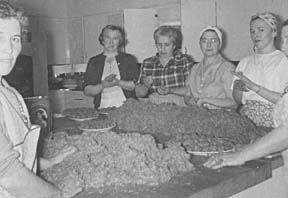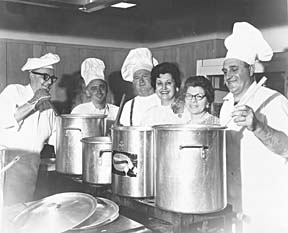 |
||||||||
| FEATURE ARTICLES | Memo Calendar | Memo Pad | Business Memo's | Loaves & Fishes | Letters | Home | ||
In 1937, a handful of Italian farming wives began cooking a spaghetti dinner for a church fundraiser. Sixty-seven years later it is a community tradition
DARLENE VINSON
THE MID-COUNTY MEMO
 |
| The founding mothers. From the late 1940’s, St. Rita parish members prepare meatballs from scratch using the same recipe that is used today. (from left) Felicina Gamenara, Mary Calcagno, Maria Garbarino, Frances Montecucco, Bess Damonte and Georgina Philapelli. |
 |
| Simmering tomato sauce has St. Rita Catholic Church smelling like an Italian café for weeks before the annual spaghetti dinner. This group of dedicated chefs from the 1960’s is (from left) Joe Jacko, Jim Pitton, Joe Wagner, Marguerite Cereghino, Rose Garre and Bert Garre. |
 |
| Lou Garre, with niece Marie Garre, enjoys family time at a St. Rita’s spaghetti dinner sometime during the 1980’s. Photos Courtesy of St. Rita Parish |
Established in 1923, the St. Rita parish served the predominantly Italian farming community of the surrounding area. The original “little brown church”, as those who remember it describe it now, was located on the corner of Northeast 102nd Avenue and Prescott Street where the Mt. Hood Community College-Maywood Park facility stands today.
As was often the custom, ladies of the parish gathered for coffee and conversation. In 1937, during one of these sessions, Livia Giannini, who happened to live next door to parish priest Father O’Flynn, mentioned the church was in need of money. The ladies, among them Josephine Garbarino, Felicina Gamenara, Rosetta Garre, Frances Montecucco, Dina Odino, Mary Damonte and Esther and Virginia Bottaro, as well as Giannini turned to what they knew best - Italian cooking. They divided the chores and set about planning a spaghetti dinner complete with salad and homemade pies. As was common then, the spaghetti noodles were fresh and homemade. The ladies of the parish each made a couple of quarts of sauce. Rose Spada, Rena Odino, Beatrice Bettendorf and Emilia Cereghino were recruited to serve tables the day of the event. Overwhelmed by the turnout, more noodles had to be hurriedly prepared while hungry diners lined up, but everyone who came that first Sunday was served and the inaugural event netted $100 for the parish.
While the dinner was prepared periodically over the next decade whenever the parish sought to raise additional funds, it wasn’t until Father Brennan’s arrival circa 1949 that the event became an annual affair. Father Brennan was looking for a regular fundraiser to supplement the church budget and turned to the Italian families for their support. It was at that time a regular date was selected - Palm Sunday. It would be early enough in the season for these farming families to put their energies toward an outside activity and it would create a natural way for the parish extended families and the rest of the Parkrose community to come together once a year.
Father Brennan also had the insight to understand that an Italian dinner was not complete without good Italian wine. Joseph and Lou Garre provided a couple gallons of their homemade wine, serving it at an additional charge and creating the cantina that is a significant money producer for the dinner to this day.
As the parish grew, a school was added at the site of the original church and by 1955 a new church was built across Prescott Street where it stands today. With each new construction project along the way, a focal point was the kitchen. The parish made sure to design a kitchen that could accommodate their popular dinner. Over the years upgrades have been made to keep up with the growth of the event.
For many years, Bert Garre, whose mother Rosetta was among the founding group of ladies, was known as the face of the spaghetti dinner and it is his writings that preserved much of the history of the dinner. He was often a buyer, a cook and a supervisor for the dinner. Sadly, Bert died suddenly days before the 2001 dinner. His wife Rose stepped in to take over his many duties. With aid from members of the parish and lots of prayer, she made it through.
Rose Garre has been involved in every spaghetti dinner since its inception. While a sophomore at Grant High school she helped serve tables at the first dinner in 1937. Her mother, Rose Spada, was also one of the founders of the dinner. Over the years Garre has been involved in every facet of this event.
MEMO Advertising | MEMO Archives | MEMO Web Neighbors | MEMO Staff | Home